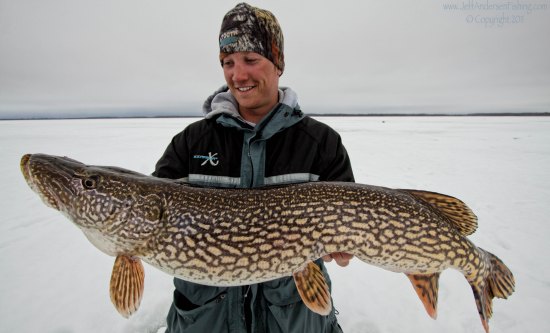If you are tired of finicky panfish or walleye with lockjaw and the slow bite that the area has been experiencing throughout this unstable portion of the winter, turn to an old favorite to heat up the action on the ice.
One of the most exciting fish to catch in our area is the northern pike. The pike, for many anglers, has gone from a childhood trophy to a secondary fish. However, winter is the time of the water wolf, there’s no better time to rediscover tip-up angling for northerns.
Pike are readily available in many lakes throughout Michigan thanks to a increased size limit two fish a day.
Furthermore, when other fish shut down during the fickle winter weather, the pike seem to always be on the prowl. The sight of a blaze orange tip-up flag tripped by a northern is a challenge welcomed by all ice anglers.
A nice pike ready to be pickled
Getting started
It doesn’t take much to get in on the action for pike in winter. A $30 stop at the fishing section of any local sporting-goods store for tip-ups, some line, leaders and trebles will have you all set for tip-up fishing. I prefer to use a single treble hook attached via 12-inch leader to 25-to-40 pound test nylon line on my tip-ups. Others may prefer heavier line or longer leaders depending on clarity of the lake being fished. If you’re fishing catch and release, try a variety of quick-strike rigs to lessen impact on the fish.
Set ‘em up…
The legal number of lines that can be used in Michigan is three. This provides tip-up anglers with a chance for some hole-dashing action.
By setting two tip-ups in high-percentage areas such as channel edge flats, or along last summer’s weedline, anglers can capitalize on known pike cruising strips. By drilling holes in other areas nearby, an angler can jig spoons or baited hooks for pike and hop around while still keeping an eye on the flags. Once you have located an area where pike are likely to be, drill several holes in the ice at different depths. This will improve your chances of finding fish. Also , while most northern pike will fit through a six inch hole, an eight or even ten inch hole will make it easier to get the fish out of the water. This is particularly true if you happen the hook a really large northern pike, which can reach a length of almost three feet.
There are a variety of tipups available on the market today
There are several brands of tip-ups, but the one I recommend and use primarily is the classic Polar Tip-Up. Its simple design and bright color make it a shoe-in for inclusion in any angler’s arsenal. Its flag-holding notch also prevents the wind from tripping the flag and sending out a false alarm.
Other options, like a variety of hole covering thermal tip-ups and the new Jig-Up, which mechanically moves your offering up and down, are available. Take a look at several different models and see what is best for your angling style.
…Knock ‘em down!
You may be dozens of yards away, in the truck, on shore, or in the icehouse when a flag trips on the tip-up. Don’t worry about missing the fish. Pike, by nature, tend to grab bait and run with it before turning it and swallowing it. As you approach the tip-up you can see the spool turning the flag trip mechanism as the pike runs. Watch for the spin to slow or even stop. A good idea once the flag pops up, is to count to twenty and then grab hold of the line. If you can see the line angling off under the ice, there’s a good chance the fish is on. Feel for tension and prepare for battle.
Bait
Pike prefer soft non-spiny rayed fish. Suckers, golden, large greys, and smelt are all good choices. Some folks use super big bait, suckers 12″ or larger are not uncommon. However, I think it’s a waste of money. In general, I don’t use anything over 7″. That is large enough to keep perch from bothering it, but small enough to keep it from setting off your traps. The bait fish is lowered into the water and kept 1 to 2 feet above the weed bed.
Pike do not have very good night vision and are usually taken during daylight hours. Unlike other fish during winter, pike are particularly active during morning and evening hours, especially on days that are overcast.
Read more: http://www.livestrong.com/article/118933-ice-fishing-tips-northern-pike/#ixzz2BskkM400
So when the walleye won’t bite, and the perch are a pain, try some tip-ups on the pike filled waters…of our outdoors.

